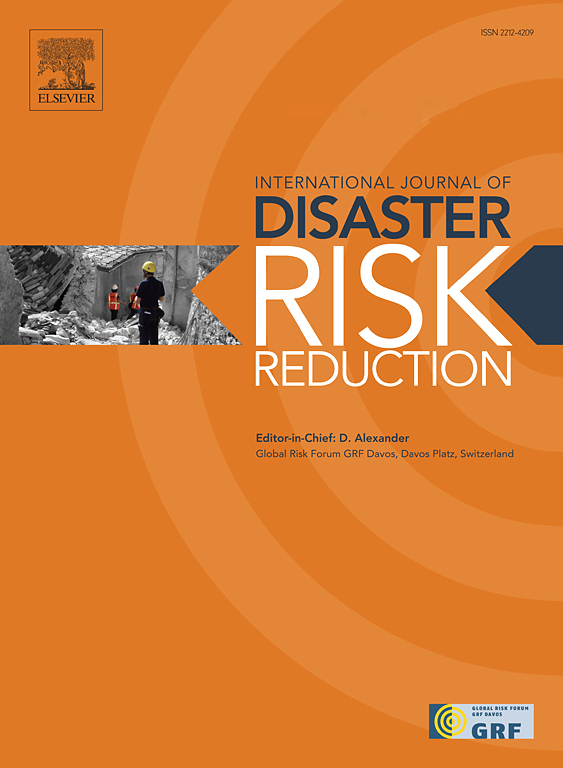IF 4.2
1区 地球科学
Q1 GEOSCIENCES, MULTIDISCIPLINARY
International journal of disaster risk reduction
Pub Date : 2025-03-13
DOI:10.1016/j.ijdrr.2025.105395
引用次数: 0
摘要
灾害地图的空间和时间演变对于发布洪水警报和启动应急计划至关重要。水文工程中心-河流分析系统(HEC-RAS)模型使用深度-速度(DV)数据生成了危害分类图。经济损失和生命损失在 HEC-FIA(水文工程中心-洪水影响分析)模型中进行了估算,并根据各政府机构提供的社会和经济数据进行了校准。研究显示,危险区域的 DV 值各不相同。H2(DV ≤ 0.6)的区域对小型车辆不安全,而 H5(DV ≤ 4.0)的区域对车辆、人员和建筑物构成威胁。H6(DV > 4.0)地区被列为高度危险地区。据估计,15 座建筑物的直接经济损失为 376,040.00 美元,其中包括 213,430.00 美元的结构性损坏、127,990.00 美元的内部损坏和 34,620.00 美元的车辆损坏。97 % 到 99 % 的人收到了警告信息,所有动员和未动员的人都幸存了下来。本文章由计算机程序翻译,如有差异,请以英文原文为准。
Hazard classification, social and economic losses in flooded urban areas
The spatial and temporal evolution of hazard maps is crucial for issuing flood alerts and activating contingency plans. Hazard classification maps were generated in the HEC-RAS ((Hydrologic Engineering Center – River Analysis System) model using Depth-Velocity (DV) data. Economic damages and loss of life were estimated in the HEC-FIA (Hydrologic Engineering Center – Flood Impact Analysis) model, calibrated with social and economic data from various government agencies. The study revealed hazardous areas with varying DV values. Regions with H2 (DV ≤ 0.6) were unsafe for small vehicles, while areas with H5 (DV ≤ 4.0) posed risks for vehicles, people, and buildings. Areas with H6 (DV > 4.0) were classified as highly hazardous. Direct economic losses were estimated at $376,040.00 for 15 structures, including $213,430.00 for structural damage, $127,990.00 for interior damage, and $34,620.00 for vehicle damage. Between 97 % and 99 % of individuals received warning messages, and all mobilised and non-mobilised individuals survived.
求助全文
通过发布文献求助,成功后即可免费获取论文全文。
去求助
来源期刊

International journal of disaster risk reduction
GEOSCIENCES, MULTIDISCIPLINARYMETEOROLOGY-METEOROLOGY & ATMOSPHERIC SCIENCES
CiteScore
8.70
自引率
18.00%
发文量
688
审稿时长
79 days
期刊介绍:
The International Journal of Disaster Risk Reduction (IJDRR) is the journal for researchers, policymakers and practitioners across diverse disciplines: earth sciences and their implications; environmental sciences; engineering; urban studies; geography; and the social sciences. IJDRR publishes fundamental and applied research, critical reviews, policy papers and case studies with a particular focus on multi-disciplinary research that aims to reduce the impact of natural, technological, social and intentional disasters. IJDRR stimulates exchange of ideas and knowledge transfer on disaster research, mitigation, adaptation, prevention and risk reduction at all geographical scales: local, national and international.
Key topics:-
-multifaceted disaster and cascading disasters
-the development of disaster risk reduction strategies and techniques
-discussion and development of effective warning and educational systems for risk management at all levels
-disasters associated with climate change
-vulnerability analysis and vulnerability trends
-emerging risks
-resilience against disasters.
The journal particularly encourages papers that approach risk from a multi-disciplinary perspective.
 求助内容:
求助内容: 应助结果提醒方式:
应助结果提醒方式:


